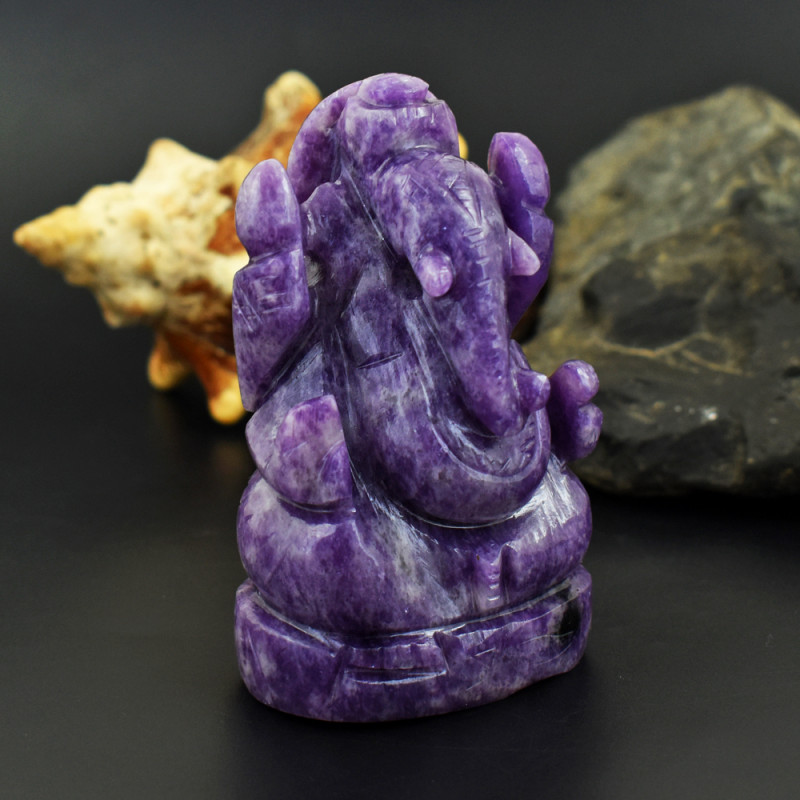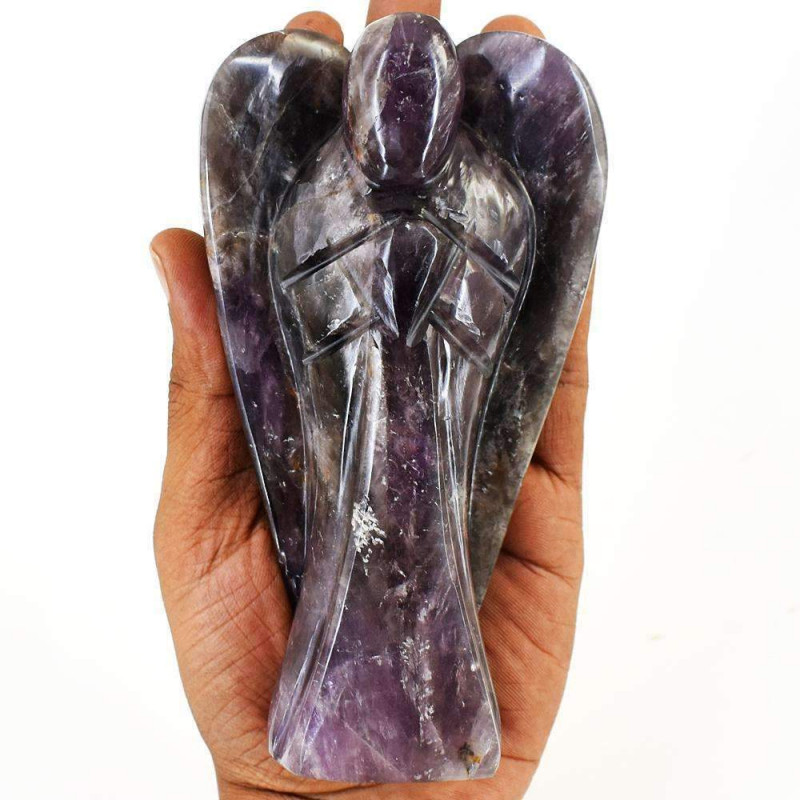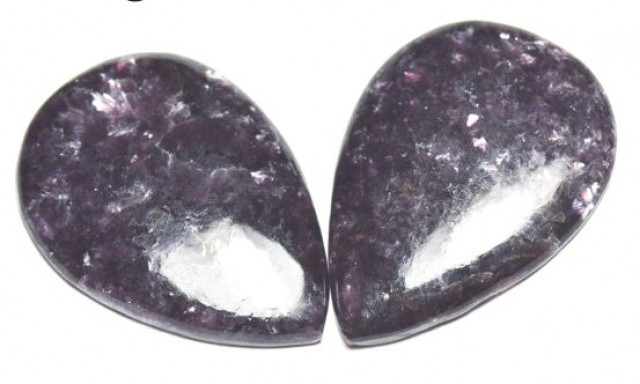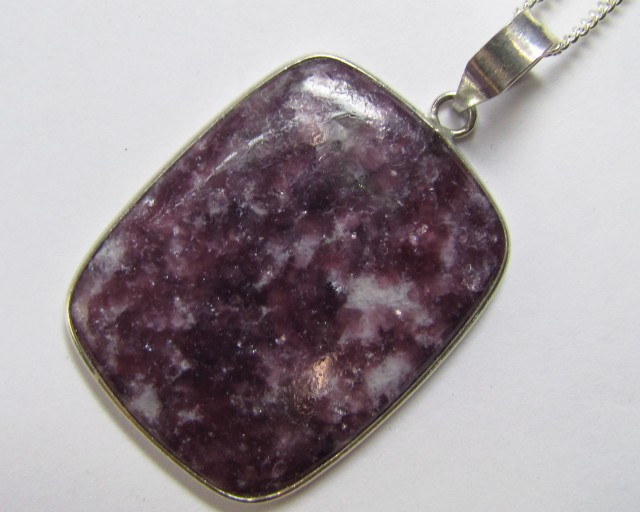Lepidolite Gemstone: Properties, Meanings, Value & More
 Lepidolite is a pale rose or lavender-gray mica mineral that contains lithium and rare metals like cesium and rubidium. Is lepidolite rare or common? Among mica minerals, lepidolite gemstones are one of the most common. However, gem-quality specimens of lepidolite are considered rare and exotic gemstones.
Lepidolite is a pale rose or lavender-gray mica mineral that contains lithium and rare metals like cesium and rubidium. Is lepidolite rare or common? Among mica minerals, lepidolite gemstones are one of the most common. However, gem-quality specimens of lepidolite are considered rare and exotic gemstones.
Wait, is lepidolite considered a gemstone? It depends on who you ask. To many geologists, lepidolites are considered minerals and not gemstones. However, most gemologists consider lepidolite a minor semi-precious gemstone.
That said, what gemstone family is lepidolite? Lepidolite belongs to the mica family, along with similar stones like muscovite and biotite.
Today, we’ll discuss all the lepidolite facts you need to know, starting with the basics.

What Is Lepidolite?
Lepidolite is a mica gem ranging from light rose or lilac to deep purple or violet. If you’re wondering, the proper lepidolite pronunciation is luh-PI-duh-lite.
These purple minerals are better known for being secondary sources of lithium. You probably have lithium in your house within rechargeable batteries, kitchen appliances, or perhaps even medications!
For our astrology lovers, lepidolite is a zodiac stone for those born under Capricorn. The calming crystal offers these hard-working folks a well-earned rest, reducing stress and anxiety.
Other marketing and trade names for lepidolite include:
Lithia mica
Lithionite
Lithionglimmer
Lavenderine
Lilalite
Lilianthite
Flower Sugilite
Mineral Characteristics
Lepidolite is an aluminum-rich mica mineral, technically in the phyllosilicate mineral family. What is lepidolite made of exactly? The stone contains potassium, silica, lithium, aluminum, iron, and often cesium and/or rubidium.
Cesium and rubidium are rare alkali metals. Quick chemistry lesson: Alkali metals can neutralize acids and are reactive with water. Cesium is more reactive than rubidium, but either placed in water leads to an immediate explosion.
Have you ever wondered how we decided a second’s length of time? How do we measure it? The answer is cesium! A cesium clock, or atomic clock, measures the precise vibration of cesium’s atoms, in simplified terms, to measure each second.
Back to the mineral at hand, the lepidolite gemstone hardness ranks from 2.5 to 4 on the Mohs mineral hardness scale. This is a low ranking, meaning most materials will scratch it. However, lepidolite has an elastic tenacity, so it will go back to its original shape if bent instead of breaking.
Despite its many unique traits, many buyers confuse lepidolite with other stones. Let’s set the record straight on what is (and isn’t) lepidolite.

Types of Lepidolite & Similar Stones
Given the greater popularity of other purple gemstones and minerals, lepidolite is commonly confused for similar-looking stones like amethyst. However, some types of lepidolite share the name of other stones.
Is purple mica the same as lepidolite? Most of the time, yes.
Some crystal experts say purple mica crystals are shiny while lepidolite is not, but lepidolite usually has a vitreous (glass-like) luster that shines. Any lithium mica, from polylithionite to trilithionite, is lepidolite.
What is the difference between lepidolite and amethyst?
Despite sharing a similar appearance, lepidolite and amethyst are entirely different stones. The most easily identifiable difference is their hardness, with amethyst ranking at 7 on the Mohs scale and lepidolite ranking from 2.5 to 4.
Chemically, lepidolite is a mica mineral, while amethyst is quartz. Lepidolite also forms in the monoclinic crystal system, while amethyst forms in the hexagonal system.
What about purple jade? Purple jade is sometimes considered a lepidolite variety, specifically a thick mass of fine-grained lepidolite usually containing impurities of other gemstones.
Learn the rest of lepidolite’s mineral properties below!
Lepidolite Specifications & Characteristics
Color: Typically pink, purple, purple-gray, or red; Can be blue, yellow, gray, or colorless
Crystal structure: Monoclinic
Luster: Pearly to vitreous
Transparency: Transparent to opaque
Refractive index: 1.52-1.58
Density: 2.8-2.9
Cleavage: Perfect basal cleavage on [001], producing flakes
Fracture: Uneven
Streak: White to colorless
Luminescence: Often fluorescent, somewhat intense; creamy white, pale yellow, or yellow
Pleochroism: Sometimes present; colorless and pink or lilac
You know the geological side, but what are lepidolite properties metaphysically?

Lepidolite Meaning
“Lepidolite” comes from the Greek lepidos, meaning “scale,” after its scaly surface. Before “lepidolite,” the stone went by lilalite, for its lilac color.
Some etymologists point to the Sanskrit term lila, meaning “divine play” as lilalite’s etymological source. In Hinduism, this term has slightly different interpretations but always ties to the concept of Brahman.
German Indologist Paul Deussen described Brahman in Motilal Banarsidass as the “creative principle which lies realized in the whole world.” In basic terms, lila describes the playful way the “divine absolute” (Brahma) created the universe.
The color of lilac lepidolite symbolizes purity, spirituality, and devotion. Lepidolite has gained the nickname “Grandmother Stone” for its comforting, peaceful associations. It also represents acceptance and trust.
Those who meditate with the stone often repeat a lepidolite affirmation along the lines of: “I release my worries” or “I accept life’s hardships as opportunities to grow.”
Speaking of its uses, what are the healing lepidolite properties?

Lepidolite Healing Properties
The colors and vibrations within crystals give them purported abilities as healing stones. Like other purple gemstones, the purple lepidolite crystal can bring passion, spirituality, and mental clarity.
Lepidolite is called a “Stone of Transition” for the belief that wearing a lepidolite necklace will bring emotional balance during major life transitions.
Let’s explore how lepidolite heals the mind and body.
Physical Healing
Outside of the alternative medicine of crystal healing, lepidolite’s lithium content has mainstream medicinal uses! Common medications with lithium treat bipolar disorder, Alzheimer’s, and anxiety disorders by acting on the central nervous system (CNS).
Similarly, crystal healers recommend lepidolite for pain relief from neuralgia or sciatica. Other reported healing uses include improving the immune system and easing menopause symptoms.
Emotional Healing
Emotionally, lepidolite can lower negative emotions like guilt, grief, and anger. Also nicknamed the “Stone of Serenity.” lepidolite is said to help you calmly respond to others’ anger, providing level-headedness and empathy.
Additionally, lepidolite crystals may bring patience and a positive outlook, helping you release self-criticism and negativity. Some crystal healers recommend the stone’s gentle empowerment to those in toxic relationships, helping them climb out of emotional dependency.
Chakra Healing
Chakra healing is the process of balancing your chakras, seven energy centers that connect to physical and emotional symptoms. Lepidolite is a chakra stone for the crown chakra, where your spirit connects to the universe.
When the crown is blocked, you might feel disconnected or crave control. Once lepidolite opens the chakra, you can feel at one with yourself and the universe.
Of course, using lepidolite as a healing stone means buying it first! Read about lepidolite’s value factors next to make sure you get a fair deal.

Lepidolite Gemstone Properties
Gemstone experts evaluate a stone’s value based on its gemstone properties. The relevant properties for the gem lepidolite include color, cut, luster, and transparency.
Color
Lepidolite may form in a number of colors, but shades on the red to purple spectrum are most common. In their purest form, mica minerals are usually off-white, maybe with brown undertones.
What makes lepidolite purple? Actually, pink, red, and purple hues in lepidolite come from manganese inclusions. While colorless, yellow, blue, or gray lepidolites are rarer, they’re generally less valuable than the pink and purple varieties.
White lepidolite spots or specks are often from quartz. Green lepidolite splotches on purple to white specimens are usually from green tourmaline inclusions.
Cut
Lepidolite crystals vary in hardness, which, combined with their perfect cleavage, make faceting the stones very difficult. On the rare occasion that they are faceted, the facets are usually long and open.
More common cuts include lepidolite beads, cabochons, and slabs. Lepidolite tumbled stones and ornamental pieces are also popular. It may be carved into figurines, frames, and ashtrays. Large lepidolite tower crystals are also great for decor.
Luster & Transparency
Lepidolite’s luster can be vitreous (glass-like) or pearly (caused by lithium flakes). Mica can make the stone glitter under light, and a vitreous luster enhances this effect.
In terms of transparency, lepidolite is usually translucent to opaque, though sometimes transparent. Translucent to transparent varieties are rarer and more valuable, but opaque lepidolite jewelry offers unique artistic charm.
How long has the world known about lepidolite’s charm? Let’s travel back through lepidolite’s history!

Lepidolite History
German chemist Martin Klaproth first described and named lepidolite in 1792. The lepidolite sample he studied came from the Czech Republic’s Vysočina region. Klaproth had a talent for mineral analysis, discovering the elements uranium, zirconium, and cerium in 1789 and 1803.
Lepidolite led to more element discoveries. In 1859, German chemist Robert Bunsen and Prussian physicist Gustav Kirchhoff invented the spectroscope together, then used it to discover cesium and rubidium. The rubidium discovery came from salts extracted from lepidolite rough!
Besides decoration, lepidolite also lends itself to glass, enamels, and glazes. It also holds importance as a source of lithium, mica flakes, cesium, and rubidium.
As a gemstone material, lepidolite or quartz-impregnated lepidolite has only started to see popularity in the past ten years or so.
Given the rarity of the elements inside, lepidolite can only form in certain conditions. So, what are the right conditions for lepidolite formation?

Lepidolite Stone Origins & Sources
Raw lepidolite can only form in environments with lots of lithium present, which are rare. The stone typically forms through late-stage magmatic crystallization, where liquid magma cools and crystals start to take form.
Lithium ions usually form at the very end of this process. They outlast other ions to create lithium-rich stones like hiddenite, petalite, or of course, lepidolite.
Lepidolite forms inside pegmatites, greisens (an altered granite), or hydrothermal quartz veins. It occurs as scattered particles, layers of flat sheets (called “books”), and aggregates of either fine grains or arched sheets. Lepidolite crystals are often leaf-like and can be separated into thin sheets, characteristic of mica minerals.
Once it forms, where can you find lepidolite?
Mining Locations
The most abundant lepidolite locales are Brazil, Canada, Madagascar, Russia’s Ural Mountains, and the USA. In the US, most lepidolite comes from California, Colorado, Connectitut, and Maine.
Other lepidolite sources include:
Afghanistan
Czech Republic
Czechoslovakia
Finland
Germany
India
Japan
Mexico
Pakistan
Sweden
Western Australia
Zimbabwe
Buyers are likely more concerned with price, so what is the value of lepidolite?
Lepidolite Price & Value
Gem-quality lepidolite can be valuable, but it’s rarely used in faceted jewelry because of its low hardness and cleavage. However, you can incorporate lepidolite cut into affordable cabochons and beads into accessories!
Lepidolite cabochons are usually around $0.50 per carat. Beaded lepidolite strands range from $2 to $35 per strand in 8-16” strands. Lepidolite carvings run from $0.02-$0.06 per carat, while rough specimens are usually $0.04-$0.50 per carat.
You may like a beaded lepidolite bracelet, but its fragility means you’ll need to know how to care for it.
Lepidolite Care and Maintenance
If you’re handling pure, raw lepidolite, you need to be careful not to let its edges crumble. Most lepidolite jewelry, however, is mixed with quartz for better durability. Still, the stone is sensitive to heat, household chemicals, and harder materials.
Can I shower with lepidolite? If it’s a quick shower, you should be okay — but we don’t recommend it. Long periods of water exposure can break down the easily crumbled lepidolite.
You can clean it with lukewarm water, mild soap, and a soft brush. Just be sure to dry it carefully with a microfiber cloth. For storage, avoid direct sunlight to prevent color fade, and keep your lepidolite away from other gems.
Leap for Joy with Lepidolite!
Lepidolite may be relatively new to the mineral market, but its history shows its potential for impressive discoveries. Like the insight gained by the scientists who studied it, you can discover your own potential by gazing into a lepidolite sphere and keeping its energies close.
Looking for a one-of-a-kind purple stone? Buy lepidolite gemstones today!
Was this article helpful?
Ross Sedawie
- Written - 19th Jan 2022
- Edited - 1st Aug 2023


















